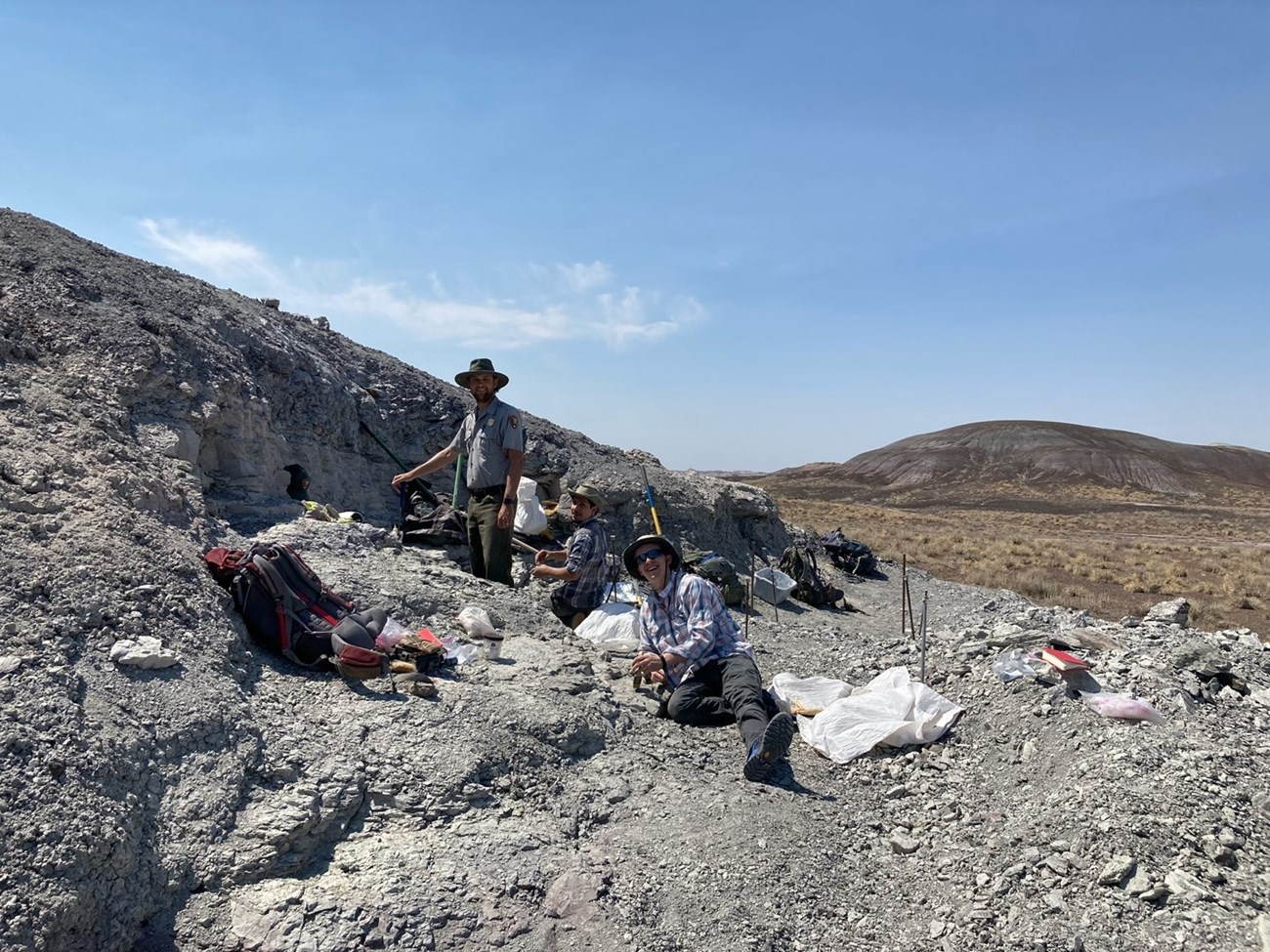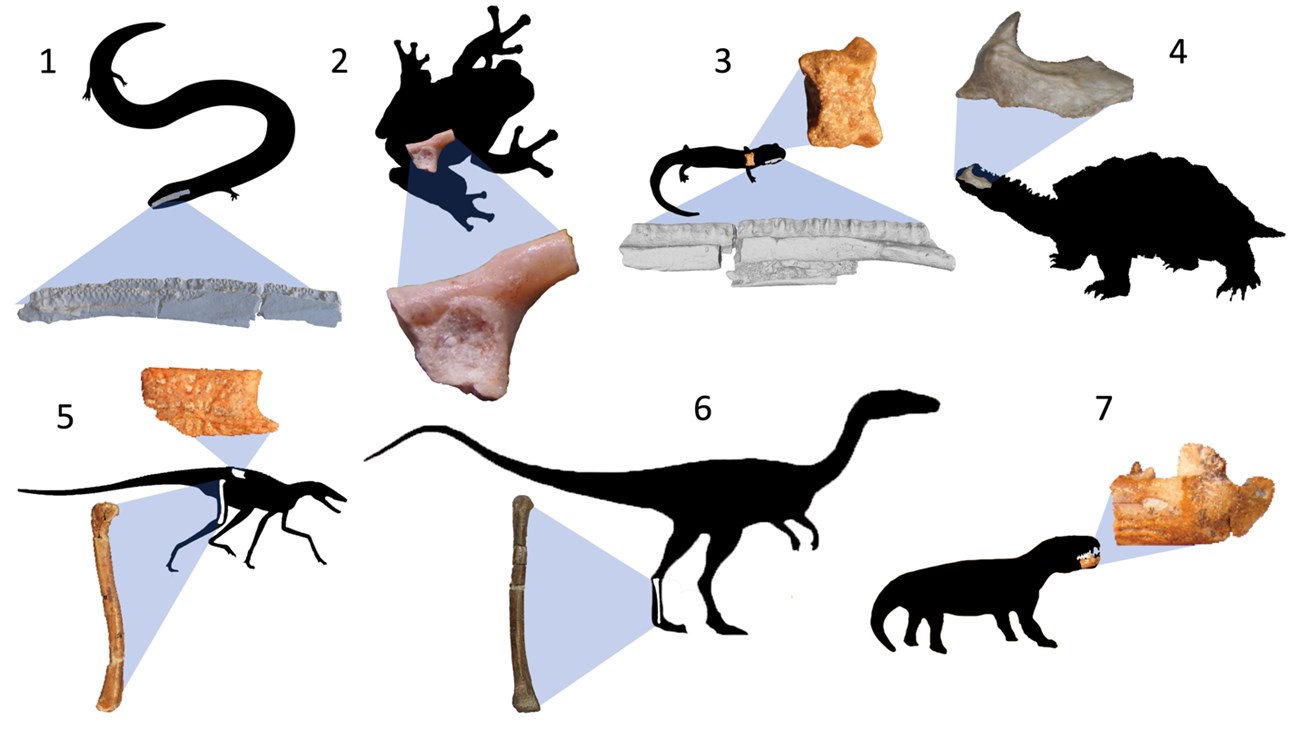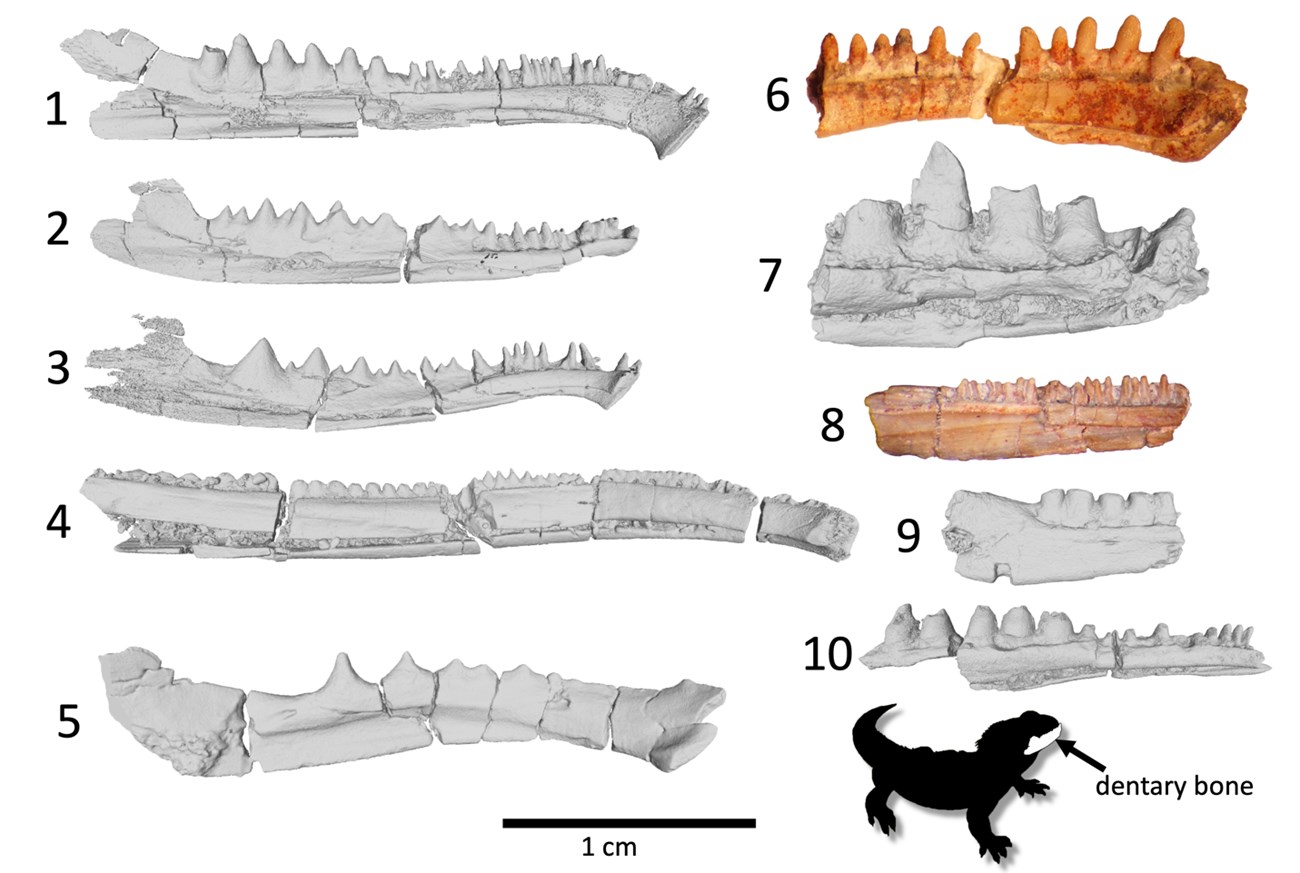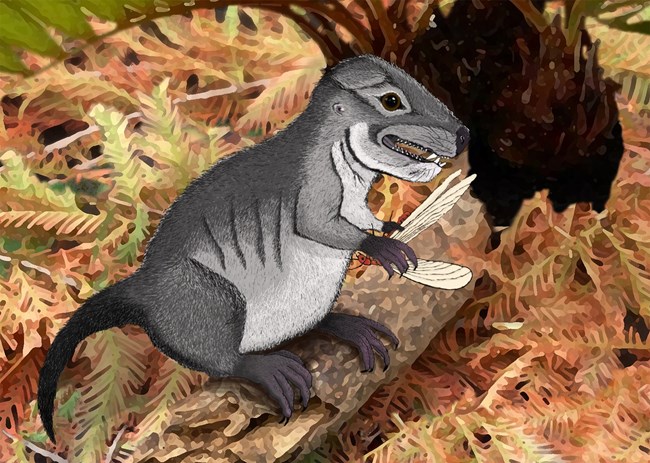Part of a series of articles titled Park Paleontology News - Vol. 13, No. 2, Fall 2021.
Article
NPS Paleontologists Discover Hidden Cradle of Tetrapod Evolution at Petrified Forest National Park: Implications for the Triassic Origins of Living Tetrapod Communities

Ben Kligman
Physical Science Technician, Petrified Forest National Park, Arizona
PhD Candidate, Department of Geoscience, Virginia Tech, Virginia

NPS photo by Ben Kligman.
Sediments deposited in the Triassic Period (251-201 million years ago: Mya) record a crucial interval in the evolutionary and ecological history of life on Earth. In the wake of the end-Permian mass extinction (250 Mya) life recovered in a rapidly changing world affected by events such as the Manicouagan asteroid impact1 (~214 Mya) and the beginning of Pangaean Supercontinent breakup (~235 Mya) which triggered massive volcanic eruptions in the rifting Atlantic Ocean leading to the end-Triassic mass extinction3 (~201 Mya). A crucial aspect of this recovery was the evolutionary rise of living tetrapod groups, as seen by the Triassic occurrence of fossils representing the earliest members of all living tetrapod groups4, including caecilians, salamanders, frogs, lizards, sphenodontians (relatives of the living Tuatara), turtles, crocodile relatives, and dinosaurs (which includes living birds). These fossils represent the dawning of modern tetrapod life that would go on to dominate global ecosystems up to the present day, and are referred to herein as the ‘living tetrapod fauna4’. Unfortunately, the Triassic records of caecilians, salamanders, frogs, lizards, sphenodontians and turtles are extremely scant, possibly because their small and delicate skeletons are unlikely to be preserved in the fossil record, or due to the difficulty for scientists to find and collect their fossils compared to the large skeletons of animals like dinosaurs. Gaps in the Triassic fossil records of these groups not only hide evidence crucial to understanding the early evolutionary history of each group respectively, but also evidence of the settings in which tetrapod communities comparable to those of today first arose. Fossil sites from Early Cretaceous (~145 Mya) rocks in Morocco have yielded the earliest reported fossil communities including all members of the ‘living tetrapod fauna’. However, the Triassic occurrence of the earliest members of this fauna suggest these communities including all these groups may have existed as early as the Middle Triassic, although localities yielding similar communities are so far unknown from the Triassic.

Stratigraphic context of Thunderstorm Ridge (PFV 456), with approximate age estimates from radioisotopic dates6,7 (1). Map of Petrified Forest National Park showing location of Thunderstorm Ridge (2). Paleogeographic reconstruction of the Earth in the Late Triassic showing approximate location of Thunderstorm Ridge (3).
In the summers of 2019 and 2021, with NPS support (PMIS 209814), Petrified Forest National Park (PEFO) paleontologists, interns, and collaborators conducted fieldwork at a Late Triassic (~220 Mya6,7) fossil site (Thunderstorm Ridge; PFV 456) in the upper Blue Mesa Member of the Chinle Formation at a recently-acquired former ranch within PEFO. 220 million years ago PEFO was located in the animal and plant rich humid tropical lowlands of central Pangaea, where a large river and lake system flowed north towards the ancestral Pacific Ocean in Nevada8. The Thunderstorm Ridge fossils were likely deposited on the margin of a lake or pond, where the skeletal remains of at least 55 vertebrate species accumulated alongside plants, crustaceans, and mollusks. Vertebrate fossils from Thunderstorm Ridge indicate the presence of freshwater sharks, lungfish, coelacanths, bony fish, amphibians, mammal relatives, and a diversity of reptiles9-12.

A selection of Thunderstorm Ridge species and their respective diagnostic skeletal elements including: (1) a stem caecilian represented by a lower jaw; (2) a stem frog represented by an ilium; (3) a stem salamander represented by a lower jaw and vertebra; (4) a stem turtle represented by a maxilla; (5) a crocodile relative represented by a femur and an osteoderm; (6) a theropod dinosaur represented by a metatarsal; (7) the stem mammal (cynodont) represented by a dentary. Lower jaws in 1 & 3 shown as 3-D digital reconstructions from CT scan data, all other bones are shown as digital photographs.
Importantly, fossils of vertebrates with small, delicate skeletal elements are exceptionally preserved, allowing for a unique understanding of an entire Late Triassic continental vertebrate community. Use of a novel fossil collection and preparation methodology developed by PEFO paleontologists13 has revealed the presence of a diversity of small-bodied tetrapod species, including 26 species new to science. These include fossils of the oldest frogs and possible salamanders known from North America, the oldest caecilian in the global fossil record, eight new species of sphenodontians and stem lizards, stem turtles, crocodile relatives, dinosaurs, and stem mammals14. These fossils are evidence of the earliest known community that includes all members of the ‘living tetrapod fauna’, pulling back the occurrence of this community type over 80 million years, indicating that a largely hidden history of tetrapod community evolution is yet to be discovered in Upper Triassic and Jurassic rocks globally.

Furthermore, the Thunderstorm Ridge fossils suggest these communities may have persisted with relative stability through major disruptions to the Earth system like the Manicouagan asteroid impact and the end-Triassic mass extinction. The novel diversity at Thunderstorm Ridge also opens new lines of scientific inquiry; for example, is this hyperdiverse fauna a signal of the diversity of the humid tropical settings of the Pangaean Supercontinent possibly preserved elsewhere on Earth? Present-day tropical ecosystems contain the bulk of living diversity, and it is possible this pattern extends back to the Triassic; however, Triassic-aged rocks deposited in these settings are rare and poorly studied outside of PEFO—this research raises the import of studying similar rocks globally to better understand the origins of present-day life and ecosystems.

Art by Ben Kligman and Hannah Kligman.
Adam Marsh, Matt Smith and William Parker provided crucial time and effort in the conceptualization, execution, and research leading to the success of this project. Charles Beightol, William Reyes, Emily Patellos, Elliot Amour Smith, Xavier Jenkins, and members of the 2019 Virginia Tech (VT) Paleobiology Research Group field team contributed to fieldwork. Cathy Lash, Debora Wagner, Diana Boudreau, and Phillip Varela contributed fossil preparation and logistical support in the PEFO laboratory and collections. This study was supported by the David R. Wones Geological Scholarship, the National Park Service (PMIS 209814), the Virginia Tech Department of Geosciences, the National Science Foundation (480383); David B. Jones Foundation; Petrified Forest Museum Association; and the Friends of Petrified Forest National Park.
References:
1) Hodych, J.P. and Dunning, G.R. 1992. Did the Manicouagan impact trigger end-of-Triassic mass extinction? Geology, 20(1), pp.51-54.
2) Manspeizer, W. 1988. Triassic–Jurassic rifting and opening of the Atlantic: an overview. Developments in Geotectonics, 22, pp.41-79.
3) Blackburn, T.J., Olsen, P.E., Bowring, S.A., McLean, N.M., Kent, D.V., Puffer, J., McHone, G., Rasbury, E.T. and Et-Touhami, M. 2013. Zircon U-Pb geochronology links the end-Triassic extinction with the Central Atlantic Magmatic Province. Science, 340(6135), pp.941-945.
4) Padian, K. and Sues, H.D. 2021. The Age of Transformation: The Triassic Period and the Rise of Today’s Land Vertebrate Fauna. In Great Transformations in Vertebrate Evolution, Dial, K.P., Shubin, N., and Brainerd, E.L. (Eds.), University of Chicago Press, pp. 351-374.
5) Ibrahim, N., Sereno, P.C., Varricchio, D.J., Martill, D.M., Dutheil, D.B., Unwin, D.M., Baidder, L., Larsson, H.C., Zouhri, S. and Kaoukaya, A. 2020. Geology and paleontology of the upper cretaceous Kem Kem group of eastern Morocco. ZooKeys, 928, p.1.
6) Ramezani J., Hoke G.D., Fastovsky D.E., Bowring S.A., Therrien F., Dworkin S.I., Atchley S.C., Nordt L.C. 2011. High-precision U-Pb zircon geochronology of the Late Triassic Chinle Formation, Petrified Forest National Park (Arizona, USA): temporal constraints on the early evolution of dinosaurs. GSA Bulletin, 123: 2142-2159.
7) Ramezani, J., Fastovsky, D.E., and Bowring, S.A. 2014. Revised chronostratigraphy of the lower Chinle Formation strata in Arizona and New Mexico (USA): high-precision U-Pb geochronological constraints on the Late Triassic evolution of dinosaurs. American Journal of Science, 314(6), pp.981-1008.
8) Atchley S.C., Nordt L.C., Dworkin S.I., Ramezani J., Parker W.G., Ash S.R., Bowring S.A. 2013. A linkage among Pangean tectonism, cyclic alluviation, climate change, and biologic turnover in the Late Triassic: the record from the Chinle Formation, southwestern United States. Journal of Sedimentary Research, 83: 1147-1161.
9) Jenkins, X.A., Pritchard, A.C., Marsh, A.D., Kligman, B.T., Sidor, C.A. and Reed, K.E. 2020. Using manual ungual morphology to predict substrate use in the Drepanosauromorpha and the description of a new species. Journal of Vertebrate Paleontology, 40(5), p.e1810058.
10) Kligman, B.T., Marsh, A.D., Nesbitt, S.J., Parker, W.G., and Stocker, M.R. 2020. New trilophosaurid species demonstrates a decline in allokotosaur diversity across the Adamanian-Revueltian boundary in the Late Triassic of western North America. Paleodiversity, 13: 25-37.
11) Marsh, A.D., and Parker, W.G. (2020). New dinosauromorph specimens from Petrified Forest National Park and a global biostratigraphic review of Triassic dinosauromorph body fossils. PaleoBios, 37.
12) Marsh, A.D., Smith, M.E., Parker, W.G., Irmis, R.B. and Kligman, B.T. 2020. Skeletal anatomy of Acaenasuchus geoffreyi Long and Murry, 1995 (Archosauria: Pseudosuchia) and its implications for the origin of the aetosaurian carapace. Journal of Vertebrate Paleontology, 40(4), p.e1794885.
13) Smith, M.E., Kligman, B., Yarborough, V., Marsh, A.D. 2020. Screenwashing, micropreparation, and micro CT: a case study of how preparation workflow facilitates research on microfossil localities at Petrified Forest National Park. Society of Vertebrate Paleontology Annual Meeting, Cleveland, Ohio (virtual talk).
14) Kligman, B., Marsh, A.D., Sues, H-D., Sidor, C.A. 2020. A new non-mammalian eucynodont from the Chinle Formation (Triassic: Norian), and implications for the early Mesozoic equatorial cynodont record, Biology Letters, DOI: 10.6084/m9.figshare. c.5182522.
Related Links
- Petrified Forest National Park, Arizona—[Geodiversity Atlas] [Park Home]
- NPS—Fossils Through Geologic Time
- NPS—Fossils and Paleontology
- NPS—Geology
Last updated: September 29, 2021
